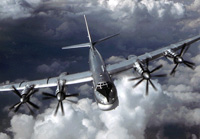Tu-95 strategic bomber: The true icon of Russia’s Air Force
The history of Russia’s renowned Tu-95 strategic bombers began at the end of the 1940s, when Soviet aerospace engineer Andrei Tupolev and his team were asked to design a bomber that could be capable of flying from the USSR to the United States and back. Tupolev’s Design Bureau (known in Russia as OKB-156) put forward a suggestion to equip the new aircraft with jet-prop engines that were much more efficient and economizing in comparison with jet engines.

Tupolev’s Design Bureau started the construction of the new strategic intercontinental bomber aircraft in the beginning of the 1950s. The first test flight of the plane was performed on November 12, 1952. The serial production of Tu-95 started in 1955 – over 500 aircraft were made. The bomber was put into service in September 1957.
Unique jet-prop engines and arrowhead wings provided the highest flight efficiency for the plane. The new plane was dubbed ‘Bear’ in the West. The bomber was outfitted with X-20 nuclear warhead missiles that were capable of hitting targets at a distance of up to 600 kilometers. One plane could carry only one missile. The aircraft produced in 1958-1962 were used until the end of the 1980s.
In addition to the USSR, Tu-95 planes were deployed in Cuba, Guinea, Angola, Somali and Vietnam. The deployment geography of the new bombers allowed the strategic command of the USSR to control practically all parts of the world. All the bombers had been withdrawn from foreign bases by the beginning of the 1990s.
Tu-95K, a modified version of the bomber, became the first missile carrier in the family of Tu-95. The next version – Tu-95KM – was outfitted with X-20M cruise missiles. Afterwards, there was Tu-95M made with enhanced NK-12M engines.
All Tu-95 bombers were subsequently modernized to the level of Tu-95M.
The next generation of Tu-95 bombers, Tu-95MS, set 60 speed and flight altitude records in 1989. The serial production of the planes was suspended after the collapse of the Soviet Union and the economic crisis in Russia.
Nowadays, Russia has 28 Tu-95MS-6 and 35 Tu-95MS-16 aircraft. Ukraine has 23 of such bombers, although all of them are now defunct.
The reliability and operational simplicity of Tu-95 did not let the plane be forgotten after the introduction of the supersonic Tu-160 missile carrier.
Western fighters were - and are - often sent to intercept Tu-95s as they performed their missions along the periphery of NATO airspace, often in very close formation.
Russian Tu-95s reportedly took part in a naval exercise off the coasts of France and Spain in January 2008, alongside Tu-22M3 Backfire strategic bombers and airborne early warning aircraft.
In October 2008, during a Russian military exercise code-named Stability-2008, Tu-95MS aircraft fired live air launched cruise missiles (ALCM) for the first time since 1984. The long range of the Raduga Kh-55 ALCM means the Tu-95MS Bears have been transformed once again into a formidable strategic weapons system.
Subscribe to Pravda.Ru Telegram channel, Facebook, RSS!





